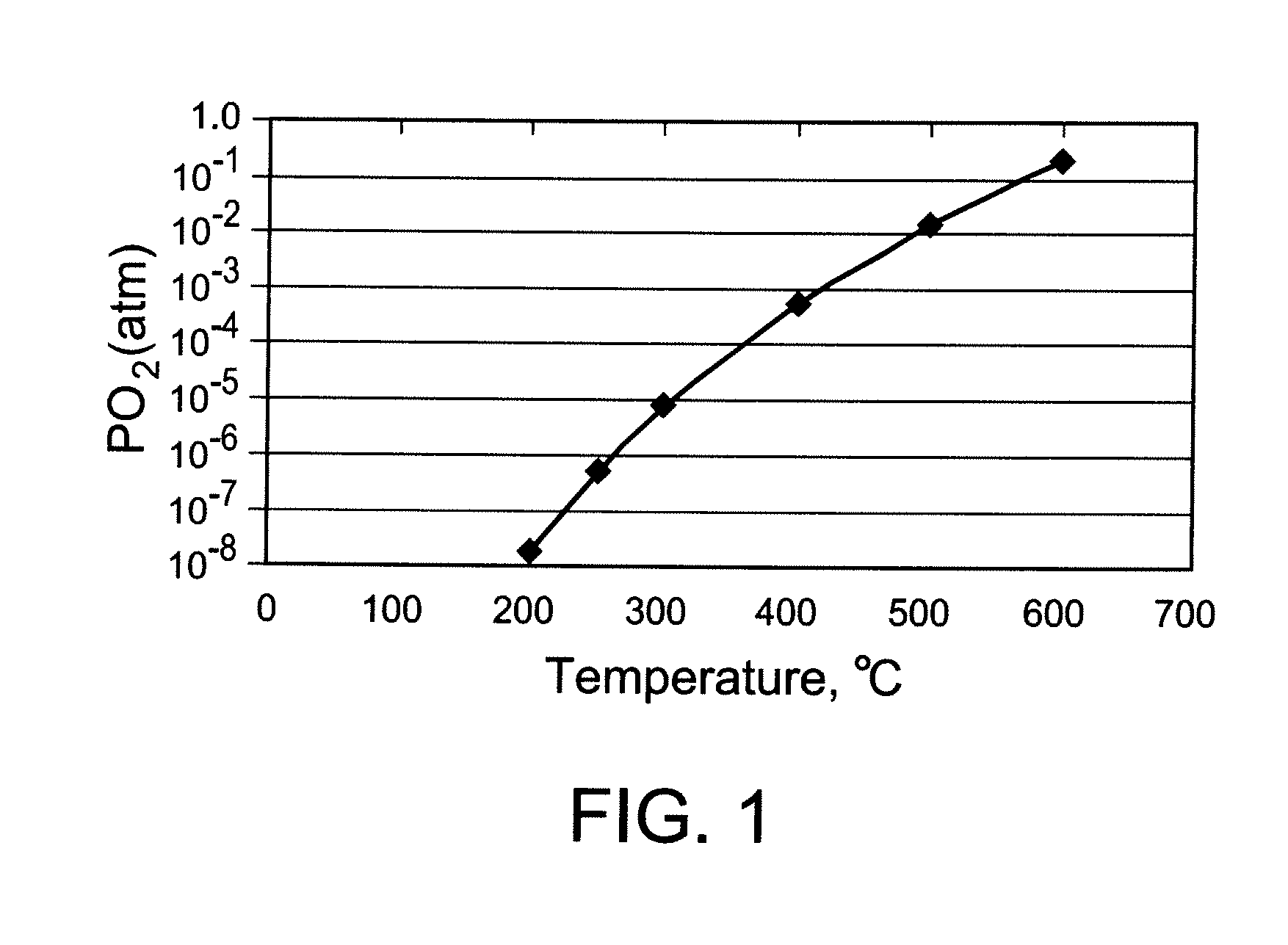Use of Impure Inert Gases in the Controlled Heating and Cooling of Mixed Conducting Metal Oxide Materials
a technology of mixed conducting metal oxide and inert gas, which is applied in the direction of liquid degasification, non-metal conductors, separation processes, etc., can solve the problems of increasing the difficulty of keeping the interior of the part in equilibrium, failure of the part, etc., and achieves the effect of increasing the oxygen activity decreasing the rate at which the temperature of the oxygen-containing gas is increased
- Summary
- Abstract
- Description
- Claims
- Application Information
AI Technical Summary
Benefits of technology
Problems solved by technology
Method used
Image
Examples
example 1
Preparation of Mixed Conducting Metal Oxide Test Specimens
[0115]Dense bars were prepared by uniaxially pressing powder of La0.4Sr0.6CoO3-δ, sintering at 1250° C. for 4 hours, and cooling to room temperature. A porous bar of the same composition was made by uniaxially pressing powder of La0.4Sr0.6CoO3-δ, sintering at 1000° C. for 1 hour, and cooling to room temperature. The bars were machined to the dimensions given in Table 1 below.
TABLE 1Dimensions of SamplesPorous BarDense BarWidth (mm)4.002.14Thickness (mm)1.841.38Length (mm)25.2226.12
example 2
Effect of Inert Gas Purity on the Dimensional Changes of Mixed Conducting Metal Oxide Samples During Isocompositional Cooling
[0116]A 2-stage dilatometer (Linsies) was used to measure simultaneously the dimensional changes in the same atmosphere of a porous bar and a dense bar made in Example 1. The bars were initially heated in air to 900° C. at 0.5° C. / min, held at 900° C. for ½ hr, and then cooled in air at 0.5° C. to 600° C. At that point the bars were isocompositionally cooled using nitrogen containing either 146 ppmv of O2 or 52 ppmv of O2. The onset of isocompositional cooling was 600° C., which means that PO2 in the gas was controlled by blending air and inert gas to maintain the oxygen vacancy fraction at the same value that is in equilibrium with 1 atm air at 600° C. A constant temperature ramp rate of 0.5° C. / min was used when cooling from 600° C. to ambient conditions.
[0117]The rigid band parameters given in Table 2 were used to calculate the PO2 required during isocompos...
example 3
Effect of Increasing Temperature Ramp Rate
[0120]A 2-stage dilatometer (Linsies) was used to measure simultaneously the dimensional changes of the two bars of Example 3 in the same atmosphere. The bars were initially heated in air to 900° C. at 0.5° C. / min, held at 900° C. for ½ hr, and then cooled in air at 0.5° C. to 600° C. At that point the bars were isocompositionally cooled using an inert gas with 146 ppmv of O2. The onset of isocompositional cooling was 600° C., and PO2 in the gas was controlled during cooling by blending air and inert gas to maintain the oxygen vacancy fraction at the same value that is in equilibrium with 1 atm air at 600° C. The rigid band parameters given in Table 2 were used as described in Example 2 to calculate the PO2 required during isocompositional cooling. A temperature ramp rate of 0.5° C. / min was used to 400° C., at which point the ramp rate was increased to 2° C. / min.
[0121]During isocompositional cooling, the target gas phase O2 concentration f...
PUM
| Property | Measurement | Unit |
|---|---|---|
| Temperature | aaaaa | aaaaa |
| Partial pressure | aaaaa | aaaaa |
| Pressure | aaaaa | aaaaa |
Abstract
Description
Claims
Application Information
 Login to View More
Login to View More - R&D
- Intellectual Property
- Life Sciences
- Materials
- Tech Scout
- Unparalleled Data Quality
- Higher Quality Content
- 60% Fewer Hallucinations
Browse by: Latest US Patents, China's latest patents, Technical Efficacy Thesaurus, Application Domain, Technology Topic, Popular Technical Reports.
© 2025 PatSnap. All rights reserved.Legal|Privacy policy|Modern Slavery Act Transparency Statement|Sitemap|About US| Contact US: help@patsnap.com



